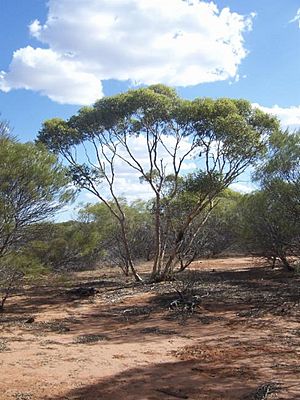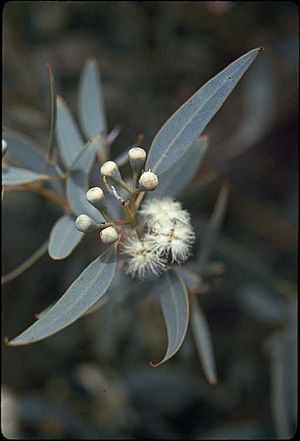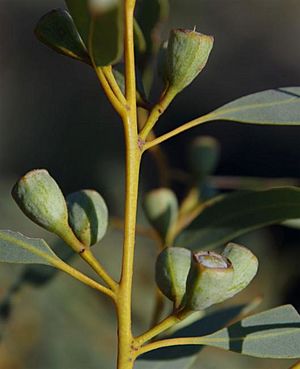Mallalie facts for kids
Quick facts for kids Mallalie |
|
|---|---|
 |
|
| Eucalyptus eudesmioides growing near Eurardy | |
| Scientific classification | |
| Genus: |
Eucalyptus
|
| Species: |
eudesmioides
|
The Mallalie (scientific name: Eucalyptus eudesmioides) is a special type of eucalyptus tree. People also call it the desert gum or mallabie. This plant is only found in Western Australia, which means it is endemic there.
The mallalie is usually a rounded, bushy plant. It has smooth bark and leaves that look like eggs or hearts. Its flower buds are shaped like clubs and grow in groups of three. When it blooms, it has pretty whitish flowers. After the flowers, it grows fruit that looks like a cylinder or a barrel.
Contents
What Does the Mallalie Look Like?
The mallalie is a type of mallee, which means it's a shrubby tree with many stems growing from the ground. It can grow from 2 to 8 meters (about 6 to 26 feet) tall. Sometimes, it can even reach 10 meters (about 33 feet), but it's usually shorter than 4 meters (13 feet).
This plant has a special woody swelling at its base called a lignotuber. This helps it regrow after fires. The bark is usually smooth and can be white, grey, or brownish. Sometimes, near the bottom of the trunk, the bark can be rough and fibrous.
Leaves and Flowers
Young mallalie plants have leaves that are directly attached to the stem (this is called sessile). These leaves are egg-shaped or heart-shaped. They are about 2.5 to 7.5 centimeters (1 to 3 inches) long.
Adult leaves are also arranged in opposite pairs. They are shaped like a spear or are slightly curved. These leaves are about 4 to 8 centimeters (1.5 to 3 inches) long. They grow on a small stalk called a petiole, which is about 3 to 10 millimeters long.
The flower buds grow in groups of three. They are found where the leaves meet the stem (this is called the leaf axil). These groups of buds grow on a stalk called a peduncle, which is 3 to 13 millimeters long. Each individual bud has its own tiny stalk, called a pedicel, about 3 to 7 millimeters long.
Mature buds are shaped like a club. They are about 5 to 7 millimeters long and 4 to 5 millimeters wide. The top part of the bud, which covers the flower, is called an operculum. It can be rounded or flat. Inside, the stamens (the parts that make pollen) are grouped in bundles.
Mallalie flowers are white and usually bloom from February to May.
Fruit
After flowering, the mallalie produces a woody fruit. This fruit is a type of capsule. It looks like a cylinder or a barrel. The fruit is about 7 to 13 millimeters long and 6 to 10 millimeters wide. The parts that open to release the seeds are called valves. They are usually at the same level as the rim of the fruit.
How the Mallalie Got Its Name
The mallalie was first officially described in 1860. A botanist named Ferdinand von Mueller gave it the scientific name Eucalyptus eudesmioides. He first wrote it as Eucalyptus eudesmoides, but then changed it slightly to the current spelling.
The second part of its scientific name, eudesmioides, refers to a group of eucalyptus plants called Eudesmia. The ending -oides is a Latin word part that means "likeness" or "similar to." So, the name means "like a Eudesmia."
The common name "Mallalie" is actually the name for this plant in the Noongar language. The Noongar people are the traditional owners of the land in southwestern Western Australia.
Where the Mallalie Lives
The mallalie grows along the coast and just inland in Western Australia. You can find it about 100 kilometers (60 miles) north of Perth. Its range stretches northwards to the Murchison River. It grows as far north as Carnarvon and south to Wongan Hills.
This plant prefers sandy soil in flat or gently sloping areas. It is often found in mallee woodlands. The mallalie is one of the eucalyptus trees found in the Eurardy Reserve. This reserve was set up in 2011 to protect native bushland.
Conservation Status
The Western Australian Government's Department of Parks and Wildlife has looked at the mallalie. They have classified this eucalypt as "not threatened." This means it is not currently at risk of disappearing.



